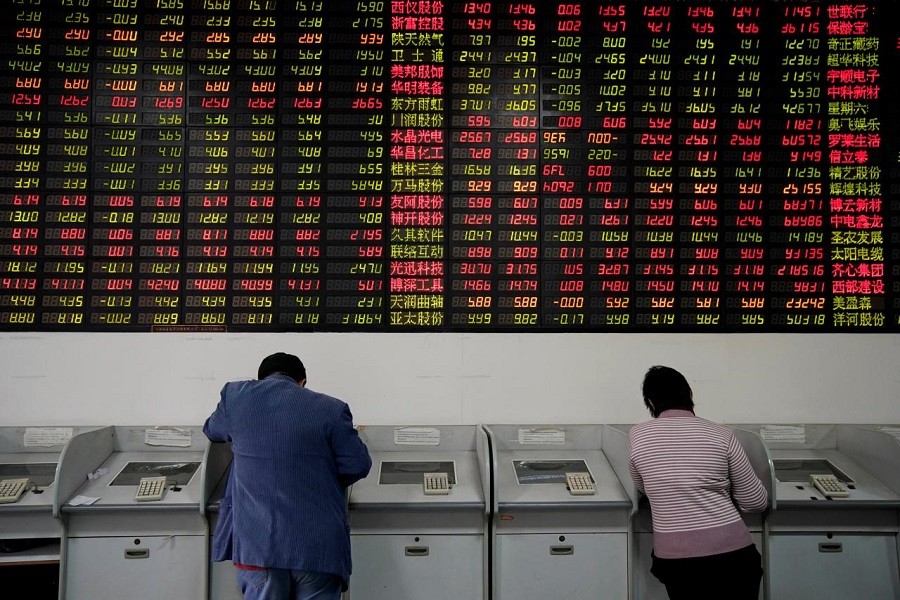Asian stocks edged higher on Thursday after the Federal Reserve delivered a much-anticipated interest rate hike but flagged caution about inflation, tempering expectations for future tightening, which weighed on the dollar and Treasury yields.
China’s central bank also raised rates, though marginally. While Chinese shares were slightly lower, the wider impact was limited.
As widely expected, the Fed raised rates for the third time this year on Wednesday while sticking to its projection for three rate increases next year.
But the policy tightening was accompanied by concerns about low inflation, toning down expectations for policy tightening in 2018. The Fed projected inflation to remain shy of its goal for another year, giving policymakers little reason to accelerate the expected pace of rate increases.
“The key takeaway from the Fed meeting was the degree of concern shown toward low inflation, which likely led to two dissenting votes,” said Junichi Ishikawa, senior FX strategist at IG Securities in Tokyo.
“The 10-year Treasury yield fell sharply on the Fed’s stance and lackluster US CPI, which shows that the markets don’t necessarily see the Fed hiking rates three times in 2018.”
The 10-year Treasury yield US10YT=RR stood little changed at 2.3547 per cent after dropping nearly 6 basis points overnight.
Data earlier on Wednesday showed US core consumer prices, which excludes volatile energy and food prices, moderated to 0.1 per cent in November from a 0.2 per cent increase in October.
The dollar index against a basket of six major currencies dipped slightly to 93.353 .DXY after sliding about 0.7 per cent on Wednesday to pull away from a one-month top of 94.219 set on Tuesday.
The Fed’s less hawkish statements supported MSCI’s broadest index of Asia-Pacific shares outside Japan .MIAPJ0000PUS, which rose 0.45 per cent.
Shanghai shares .SSEC and the Chinese yuan were marginally lower after the Peoples' Bank of China hiked the reverse repo rate by 5 basis points to 2.50 per cent and raised the one-year medium-term lending facility (MLF) rate by 5 basis points to 3.25 per cent.
Australian stocks added 0.1 per cent and South Korea's KOSPI .KS11 climbed 0.8 per cent.
Japan's Nikkei .N225 bucked the broader trend and lost 0.15 per cent, weighed by the weaker dollar.
The dollar was little changed at 112.620 yen JPY= after losing 0.9 per cent overnight.
The euro added 0.15 per cent to $1.1841 EUR= following gains of 0.7 per cent the previous day.
The European Central Bank is expected to stand pat on monetary policy when it announces its decision later in the global day, but investors will eye President Mario Draghi’s views on the euro zone economy for potential incentives.
The pound was effectively flat at $1.3423 GBP=D3. Investors will sift through the Bank of England's views on Brexit when the central bank announces its policy decision later on Thursday. The BoE is seen holding policy steady after raising rates last month for the first time since 2007.
Prime Minister Theresa May’s government was defeated on Wednesday, when lawmakers forced through changes to its Brexit blueprint that ministers said could endanger Britain’s departure from the European Union. Lawmakers voted in favor of an amendment to the EU withdrawal bill giving parliament more say over any final exit deal.
In commodities, US crude futures CLc1 rose 0.3 per cent to $56.78, lifted by the weaker dollar.
Oil prices had slipped for a second straight day on Wednesday, as a slump in US crude stockpiles was offset by a larger-than-forecast rise in gasoline inventories and as US crude output continued to grow to record highs. [O/R]
Spot gold XAU= rose 0.15 per cent to $1,257.10 an ounce.
A lower dollar generally makes dollar-priced commodities like oil and gold cheaper for non-US investors, boosting demand.


